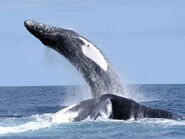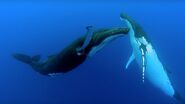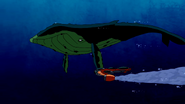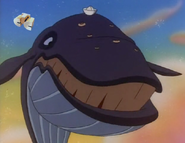
Humpback whale breaching
The humpback whale (Megaptera novaeangliae) is a species of baleen whale. One of the larger rorqual species, adults range in length from 12–16 m (39–52 ft) and weigh about 36,000 kg (79,000 lb). The humpback has a distinctive body shape, with long pectoral fins and a knobbly head. It is known for breaching and other distinctive surface behaviors, making it popular with whale watchers. Males produce a complex song lasting 10 to 20 minutes, which they repeat for hours at a time. Its purpose is not clear, though it may have a role in mating.
Found in oceans and seas around the world, humpback whales typically migrate up to 25,000 km (16,000 mi) each year. Humpbacks feed only in summer, in polar waters, and migrate to tropical or subtropical waters to breed and give birth in the winter when they fast and live off their fat reserves. Their diet consists mostly of krill and small fish. Humpbacks have a diverse repertoire of feeding methods, including the bubble net technique.
Like other large whales, the humpback was a target for the whaling industry. Once hunted to the brink of extinction, its population fell by an estimated 90% before a 1966 moratorium. While stocks have partially recovered, entanglement in fishing gear, collisions with ships, and noise pollution continue to impact the population of 80,000.
Anatomy[]
A humpback whale can easily be identified by its stocky body, obvious hump, black dorsal coloring, and elongated pectoral fins. The head and lower jaw are covered with knobs called tubercles, which are hair follicles, and are characteristic of the species. The fluked tail, which it typically lifts above the surface when diving, has wavy trailing edges.
Humpbacks have 270 to 400 darkly colored baleen plates on each side of their mouths. The plates measure from 18 in (46 cm) in the front to about 3 ft (0.91 m) in the back, behind the hinge. Ventral grooves run from the lower jaw to the umbilicus about halfway along the underside of the whale. These grooves are less numerous (usually 14–22) than in other rorquals, but are fairly wide. The female has a hemispherical lobe about 15 cm (5.9 in) in diameter in her genital region. This visually distinguishes males and females. The male's penis usually remains hidden in the genital slit.
Size[]
Fully grown males average 13–14 m (43–46 ft). Females are slightly larger at 15–16 m (49–52 ft); one large recorded specimen was 19 m (62 ft) long and had pectoral fins measuring 6 m (20 ft) each. The largest humpback on record, according to whaling records, was a female killed in the Caribbean; she was 27 m (89 ft) long with a weight of 90 metric tons (99 short tons), although the reliability of this information is unconfirmed due to illogicality of the record. Body mass typically is in the range of 25–30 metric tons (28–33 short tons), with large specimens weighing over 40 metric tons (44 short tons).
Newborn calves are roughly the length of their mother's head. At birth, calves measure 6 m (20 ft) at 2 short tons (1.8 t). They nurse for about six months, then mix nursing and independent feeding for possibly six months more. Humpback milk is 50% fat and pink in color. Females reach sexual maturity at age five, achieving full adult size a little later. Males reach sexual maturity around seven years of age.
Fins[]
The long black and white tail fin, which can be up to a third of body length. The pectoral fins have unique patterns, which make individual whales identifiable. Several hypotheses attempt to explain the humpback's pectoral fins, which are proportionally the longest fins of any cetacean. Possibly the higher maneuverability afforded by long fins and the usefulness of the increased surface area for temperature control when migrating between warm and cold climates supported this adaptation.
Identifying individuals[]
The varying patterns on the tail flukes are sufficient to identify individuals. A study using data from 1973 to 1998 on whales in the North Atlantic gave researchers detailed information on gestation times, growth rates, and calving periods, as well as allowing more accurate population predictions by simulating the mark-release-recapture technique. A photographic catalogue of all known North Atlantic whales was developed over this period and is maintained by College of the Atlantic. Similar photographic identification projects operate around the world.
Life History/Behavior[]
The lifespan of rorquals ranges from 45 to 100 years.
Courtship and Reproduction[]
Courtship rituals take place during the winter months, following migration toward the equator from summer feeding grounds closer to the poles. Competition is usually fierce, and unrelated males, dubbed escorts, frequently trail females, as well as cow-calf pairs. Males gather into "competitive groups" around a female and fight for the right to mate with her. Group size ebbs and flows as unsuccessful males retreat and others arrive. Behaviors include breaching, spyhopping, lob-tailing, tail-slapping, pectoral fin-slapping, peduncle throws, charging, and parrying.
Whale song is thought to have an important role in mate selection; however, they may also be used between males to establish dominance. Females typically breed every two or three years. The gestation period is 11.5 months. The peak months for birth are January, February (Northern Hemisphere), July and August (Southern Hemisphere). Females generally take a one- to two–year break after breeding. Recent research on mitochondrial DNA reveals that groups living in proximity to each other may represent distinct breeding pools.
Song[]
Both male and female humpback whales vocalize, but only males produce the long, loud, complex "song" for which the species is famous. Each song consists of several sounds in a low register, varying in amplitude and frequency, and typically lasting from 10 to 20 minutes. Individuals may sing continuously for more than 24 hours. Cetaceans have no vocal cords, so generate their songs by forcing air through their massive nasal cavities (blowholes). Whales within a large area sing a single song. All North Atlantic humpbacks sing the same song, while those of the North Pacific sing a different song. Each population's song changes slowly over a period of years without repeating.
Scientists are unsure of the purpose of whale songs. Only males sing, suggesting one purpose is to attract females. However, many of the whales observed to approach a singer are other males, often resulting in conflict. Singing may, therefore, be a challenge to other males. Some scientists have hypothesized the song may serve an echolocative function. During the feeding season, humpbacks make unrelated vocalizations for herding fish into their bubble nets. Humpback whales have also been found to make a range of other social sounds to communicate, such as grunts, groans, "thwops", snorts, and barks.
Migration[]
Migratory patterns and social interactions were explored in the 1960s and by further studies in 1971. The Calambokidis et al. 2001 report provided the "first quantitative assessment of the migratory structure of humpback whales in the entire North Pacific basin."
Ecology[]
Range and habitat[]
Humpbacks inhabit all major oceans, in a wide band running from the Antarctic ice edge to 77° N latitude. The four global populations are North Pacific, Atlantic, Southern Ocean, and Indian Ocean populations. These populations are distinct. Although the species has cosmopolitan distribution and is usually not considered to cross the equator line, seasonal observations at Cape Verde suggest possible utilizes by populations from both hemisphere. Recent increases within Mediterranean basin including re-sightings indicate more whales may migrate into the inland sea in the future.
Whales were once uncommon in the eastern Mediterranean or the Baltic Sea, but have increased their presence in both waters as global populations have recovered. They have also returned to Skagerrak and Kattegat, as well as Scandinavian fjords such as the Kvænangen, where they had not been observed for a long time.
In the North Atlantic, humpack whale stocks have feeding areas ranging from Scandinavia to New England and breed in the Caribbean and Cape Verde. In the South Atlantic and Indian Oceans, whales stocks may breed off Brazil, as well the coasts of gentral, southern and southeastern Africa (including Madagascar). Whales' visits into Gulf of Mexico have been infrequent, but earlier occur in the gulf historically. In South Atlantic, about 10% of world population of the species possibly migrate to Gulf of Guinea. Comparison of songs between those at Cape Lopez and Abrolhos Archipelago indicate that trans-Atlantic mixings between western and southeastern populations occur.
A large population spreads across the Hawaiian Islands every winter, ranging from the island of Hawaii in the south to Kure Atoll in the north. These animals feed in areas ranging from the coast of California to the Bering Sea. Humpbacks were first observed in Hawaiian waters in the mid-19th century, and might have gained a dominance over North Pacific right whales as the right whales were hunted to near-extinction.
A 2007 study identified seven individuals wintering off the Pacific coast of Costa Rica as having traveled from the Antarctic—around 8,300 km (5,200 mi). Identified by their unique tail patterns, these animals made the longest documented mammalian migration. In Australia, two main migratory populations have been identified, off the west and east coasts. These two populations are distinct, with only a few females in each generation crossing between the two groups.
In Panama and Costa Rica, humpback whales come from both the Southern Hemisphere, July–October with over 2,000 whales, and the Northern Hemisphere, December–March numbering about 300. South Pacific populations migrating off mainland New Zealand, Kermadec Islands, and Tasmania are increasing, but less rapidly than in Australian waters because of illegal whaling by the Soviet Union in the 1970s.
Some recolonizing habitats are confirmed especially in North and South Atlantic (e.g. English and Irish coasts, English Channel to coasts in the north such as the North Sea and Wadden Sea, South Pacific (e.g. New Zealand coasts and Niue), pelagic islands of Chile such as Isla Salas y Gómez and the Easter Island where possibilities of undocumented wintering grounds have been considered, southern fiords of Chile and Peru (e.g. Gulf of Penas, Strait of Magellan, Beagle Channel) and in Asia. Areas in the Philippines such as in Babuyan Islands, Cagayan and Calayan and Pasaleng Bay, Ryukyu Islands the Volcano Islands in Japan and the Northern Mariana Islands recently, again became stable/growing wintering grounds while Marshall Islands, Vietnamese, Taiwanese, and Chinese coasts show slow or no obvious recovery. Off Japanese coasts, whales again began to migrate off Japanese archipelagos and into Sea of Japan. Connections between these stocks and whales seen in Sea of Okhotsk, on Kamchatka coasts, and around Commander Islands have been studied. Historical wintering distributions could have been much wider than the current statuses, as whales were seen areas along Batanes, Sulu and Celebes Seas including off Palawan, Malaysia, and Mindanao with higher densities at around today's Cape Eluanbi and Kenting National Park. Handful of unconfirmed sightings have been reported vicinity to Borneo in Modern. The first confirmation in modern Taiwan was of a sighting of a pair off Hualien in 1994, followed by successful fleeing from entanglement off Taitung in 1999, and continuous sightings around Orchid Island in 2000. None or if very few whales still migrate into waters of Kenting National Park regularly. In addition, despite sightings have been reported almost annually at the islands of Green and Orchid Islands in recent years, relative short stays in these waters indicate recoveries as winter forging grounds has not occurred. Around Hong Kong, two documented sightings have been recorded in 2009 and in 2016.
Feeding and Predation[]
Humpbacks feed primarily in summer and live off fat reserves during winter. They feed only rarely and opportunistically in their wintering waters. The humpback is an energetic hunter, taking krill and small schooling fish such as herring, salmon, capelin, and American sand lance, as well as Atlantic mackerel, pollock, and haddock in the North Atlantic. Krill and copepods are prey species in Australian and Antarctic waters. Humpbacks hunt by direct attack or by stunning prey by hitting the water with pectoral fins or flukes.
Bubble Net[]
The humpback has the most diverse hunting repertoire of all baleen whales. Its most inventive technique is known as bubble net feeding; a group of whales swims in a shrinking circle blowing bubbles below a school of prey. The shrinking ring of bubbles encircles the school and confines it in an ever-smaller cylinder. This ring can begin near 30 m (98 ft) in diameter and involve the cooperation of a dozen animals. Using a crittercam attached to a whale's back, researchers found that some whales blow the bubbles, some dive deeper to drive fish toward the surface, and others herd prey into the net by vocalizing. The whales then suddenly swim upward through the "net", mouths agape, swallowing thousands of fish in one gulp. Pleated grooves in the whale's mouth allow the creature to easily drain all the water initially taken in.
So-called lobtail feeding was observed among humpback whales in the North Atlantic. This technique involves the whale slapping the surface of the ocean with its tail between one and four times before creating the bubble net. Using network-based diffusion analysis, study authors argued that these whales learned the behavior from other whales in the group over a period of 27 years in response to a change in the primary form of prey.
Killer whale Predation[]
Visible scars indicate that killer whales can prey upon juvenile humpbacks, though until recently hunting had never been witnessed, and attacks were assumed to be superficial in nature. However, a 2014 study off Western Australia observed that when available in large numbers, young humpbacks will be attacked and sometimes killed by orcas. Moreover, mothers and (possibly related) adults escort neonates to avoid such predation. The suggestion is that when humpbacks suffered near-extinction during the whaling era, the orcas turned to other prey, but are now resuming this former activity.














